HONDA PRELUDE 1998 Owners Manual
Manufacturer: HONDA, Model Year: 1998, Model line: PRELUDE, Model: HONDA PRELUDE 1998Pages: 278, PDF Size: 2.61 MB
Page 241 of 278
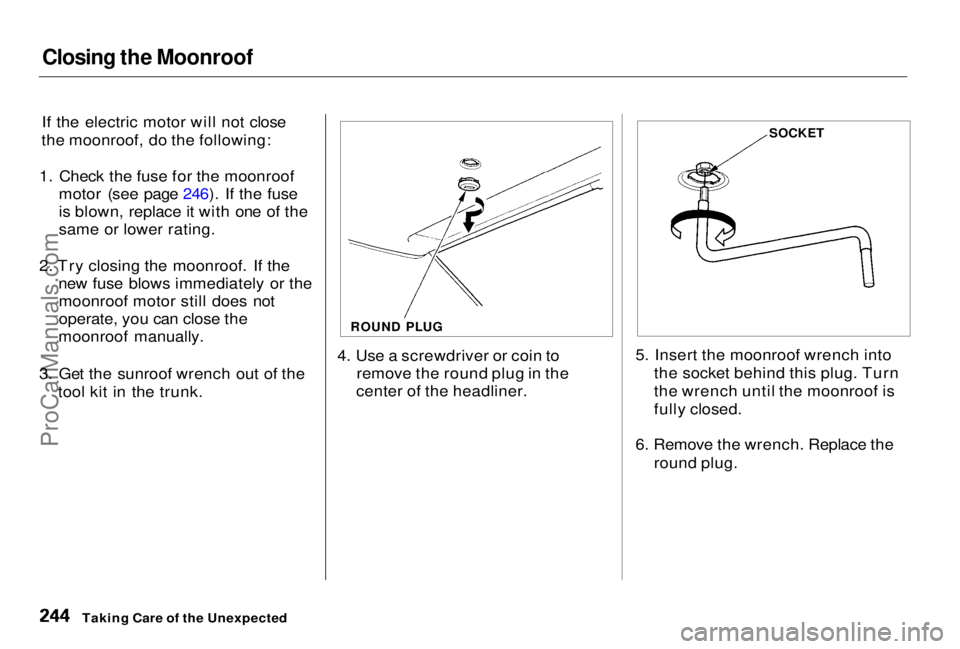
Closing the Moonroof
If the electric motor will not close
the moonroof, do the following:
1. Check the fuse for the moonroof motor (see page 246). If the fuse
is blown, replace it with one of the
same or lower rating.
2. Try closing the moonroof. If the new fuse blows immediately or themoonroof motor still does not
operate, you can close the
moonroof manually.
3. Get the sunroof wrench out of the tool kit in the trunk. 4. Use a screwdriver or coin to
remove the round plug in the
center of the headliner. 5. Insert the moonroof wrench into
the socket behind this plug. Turn
the wrench until the moonroof is
fully closed.
6. Remove the wrench. Replace the round plug.
Taking Care of the Unexpected
ROUND PLUG
SOCKETProCarManuals.comMain Menu Table of Contents s t
Page 242 of 278
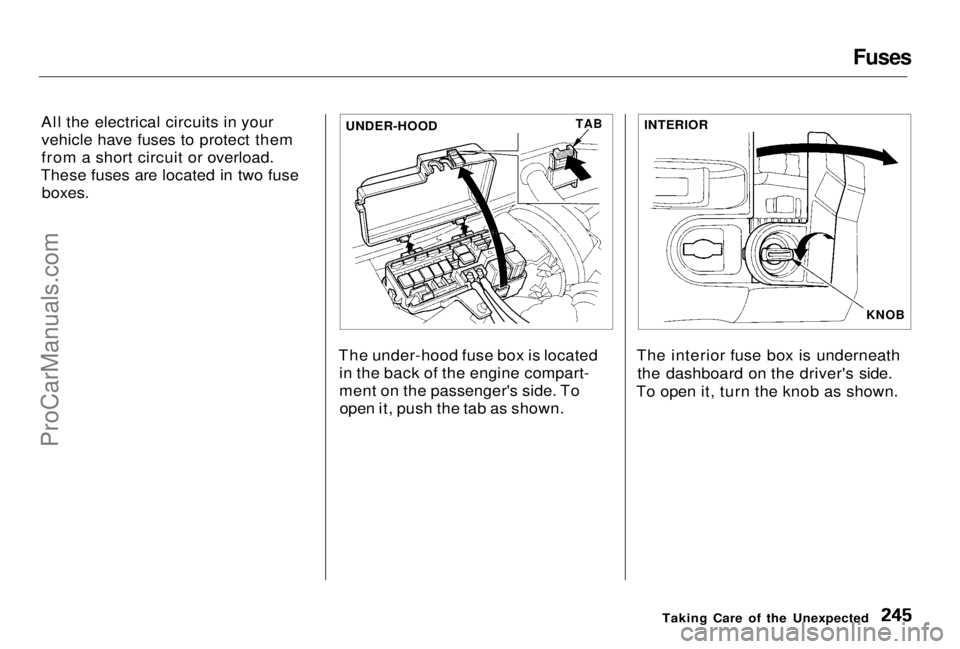
Fuses
All the electrical circuits in your vehicle have fuses to protect them
from a short circuit or overload.
These fuses are located in two fuse boxes.
The under-hood fuse box is locatedin the back of the engine compart-
ment on the passenger's side. Toopen it, push the tab as shown. The interior fuse box is underneath
the dashboard on the driver's side.
To open it, turn the knob as shown.
Taking Care of the Unexpected
UNDER-HOOD
TAB
INTERIOR
KNOBProCarManuals.comMain Menu Table of Contents s t
Page 243 of 278
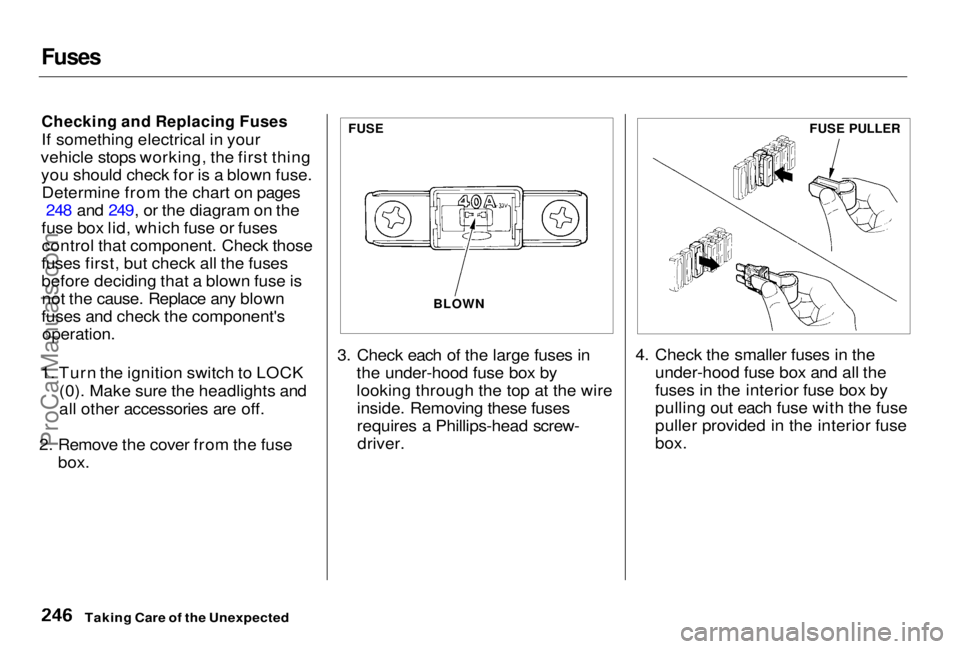
Fuses
Checking and Replacing Fuses
If something electrical in your
vehicle stops working, the first thing you should check for is a blown fuse. Determine from the chart on pages 248 and 249, or the diagram on the
fuse box lid, which fuse or fuses control that component. Check those
fuses first, but check all the fuses
before deciding that a blown fuse is not the cause. Replace any blown
fuses and check the component's
operation.
1. Turn the ignition switch to LOCK (0). Make sure the headlights and
all other accessories are off.
2. Remove the cover from the fuse
box.
3. Check each of the large fuses in
the under-hood fuse box by
looking through the top at the wireinside. Removing these fuses
requires a Phillips-head screw-driver. 4. Check the smaller fuses in the
under-hood fuse box and all the
fuses in the interior fuse box by
pulling out each fuse with the fuse
puller provided in the interior fuse
box.
Taking Care of the Unexpected
FUSE
BLOWN
FUSE PULLERProCarManuals.comMain Menu Table of Contents s t
Page 244 of 278
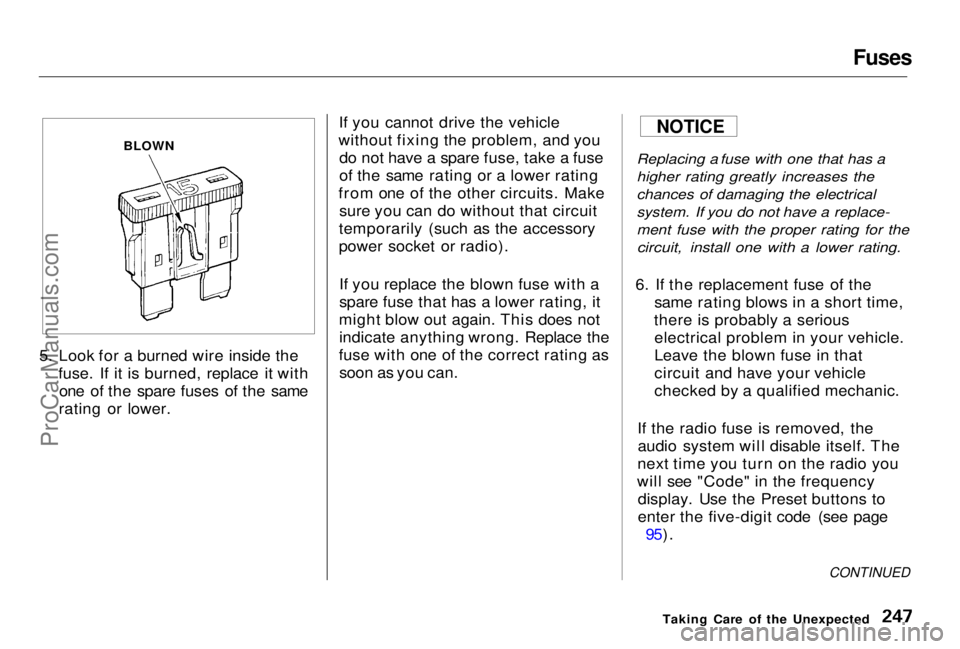
Fuses
5. Look for a burned wire inside the fuse. If it is burned, replace it withone of the spare fuses of the same
rating or lower. If you cannot drive the vehicle
without fixing the problem, and you do not have a spare fuse, take a fuse
of the same rating or a lower rating
from one of the other circuits. Make sure you can do without that circuit
temporarily (such as the accessory
power socket or radio).
If you replace the blown fuse with a
spare fuse that has a lower rating, it
might blow out again. This does not indicate anything wrong. Replace the
fuse with one of the correct rating as soon as you can.
Replacing a fuse with one that has a
higher rating greatly increases the
chances of damaging the electrical
system. If you do not have a replace-
ment fuse with the proper rating for the
circuit, install one with a lower rating.
6. If the replacement fuse of the same rating blows in a short time,
there is probably a serious electrical problem in your vehicle.
Leave the blown fuse in that
circuit and have your vehicle
checked by a qualified mechanic.
If the radio fuse is removed, the audio system will disable itself. The
next time you turn on the radio you
will see "Code" in the frequency display. Use the Preset buttons to
enter the five-digit code (see page 95).
Taking Care of the Unexpected
CONTINUED
NOTICE
BLOWNProCarManuals.comMain Menu Table of Contents s t
Page 245 of 278
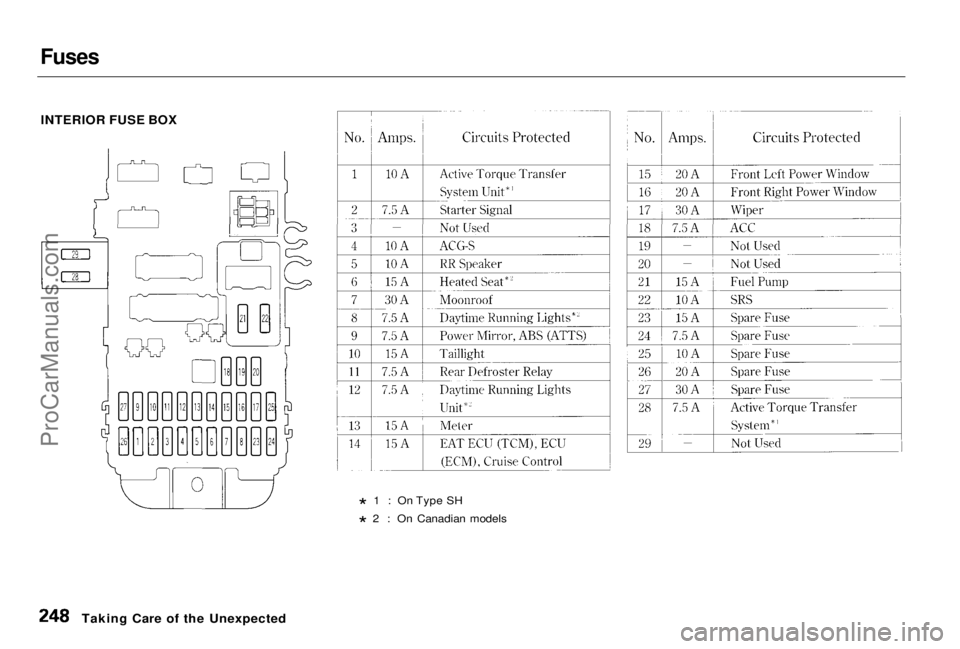
Fuses
INTERIOR FUSE BOX
* 1 : On Type SH
* 2 : On Canadian models
Taking Care of the UnexpectedProCarManuals.comMain Menu Table of Contents s t
Page 246 of 278
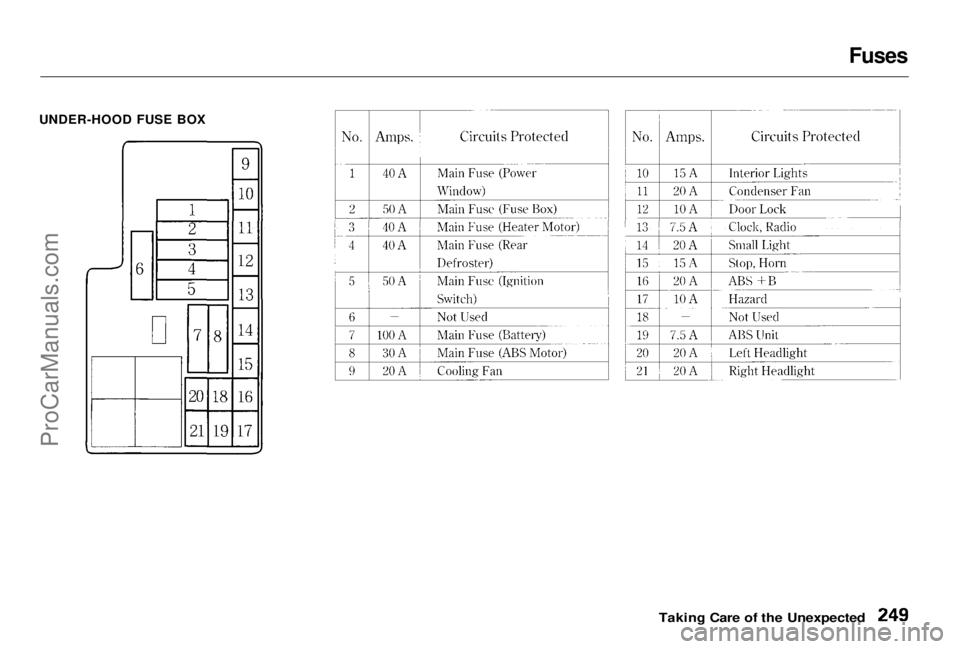
Fuses
UNDER-HOOD FUSE BOX
Taking Care of the UnexpectedProCarManuals.comMain Menu Table of Contents s t
Page 247 of 278
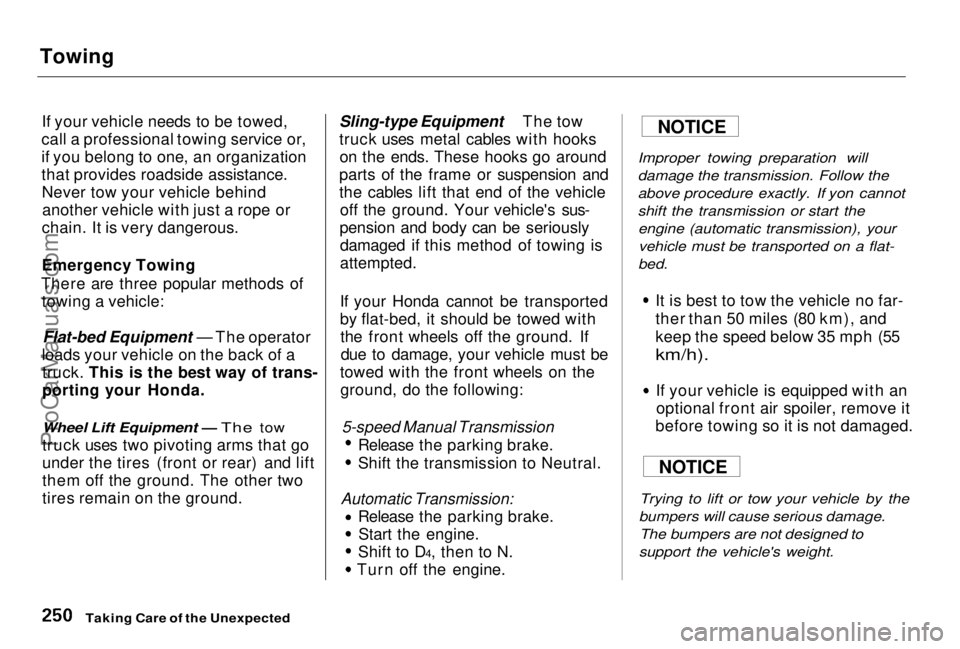
Towing
If your vehicle needs to be towed,
call a professional towing service or,
if you belong to one, an organization
that provides roadside assistance. Never tow your vehicle behindanother vehicle with just a rope or
chain. It is very dangerous.
Emergency Towing
There are three popular methods of towing a vehicle:
Flat-bed Equipment — The operator
loads your vehicle on the back of a truck. This is the best way of trans-
porting your Honda.
Wheel Lift Equipment — The tow
truck uses two pivoting arms that go
under the tires (front or rear) and lift
them off the ground. The other two
tires remain on the ground. Sling-type Equipment The tow
truck uses metal cables with hooks
on the ends. These hooks go around
parts of the frame or suspension and
the cables lift that end of the vehicle off the ground. Your vehicle's sus-
pension and body can be seriously damaged if this method of towing is
attempted.
If your Honda cannot be transported
by flat-bed, it should be towed withthe front wheels off the ground. Ifdue to damage, your vehicle must be
towed with the front wheels on the ground, do the following:
5-speed Manual Transmission
Release the parking brake.
Shift the transmission to Neutral.
Automatic Transmission:
Release the parking brake.
Start the engine.
Shift to D4, then to N.
Turn off the engine.
Improper towing preparation will
damage the transmission. Follow the
above procedure exactly. If yon cannot
shift the transmission or start the
engine (automatic transmission), yourvehicle must be transported on a flat-
bed.
It is best to tow the vehicle no far-
ther than 50 miles (80 km), and
keep the speed below 35 mph (55
km/h).
If your vehicle is equipped with an
optional front air spoiler, remove it
before towing so it is not damaged.
Trying to lift or tow your vehicle by the
bumpers will cause serious damage. The bumpers are not designed to
support the vehicle's weight.
Taking Care of the Unexpected
NOTICE
NOTICE
ProCarManuals.comMain Menu Table of Contents s t
Page 248 of 278
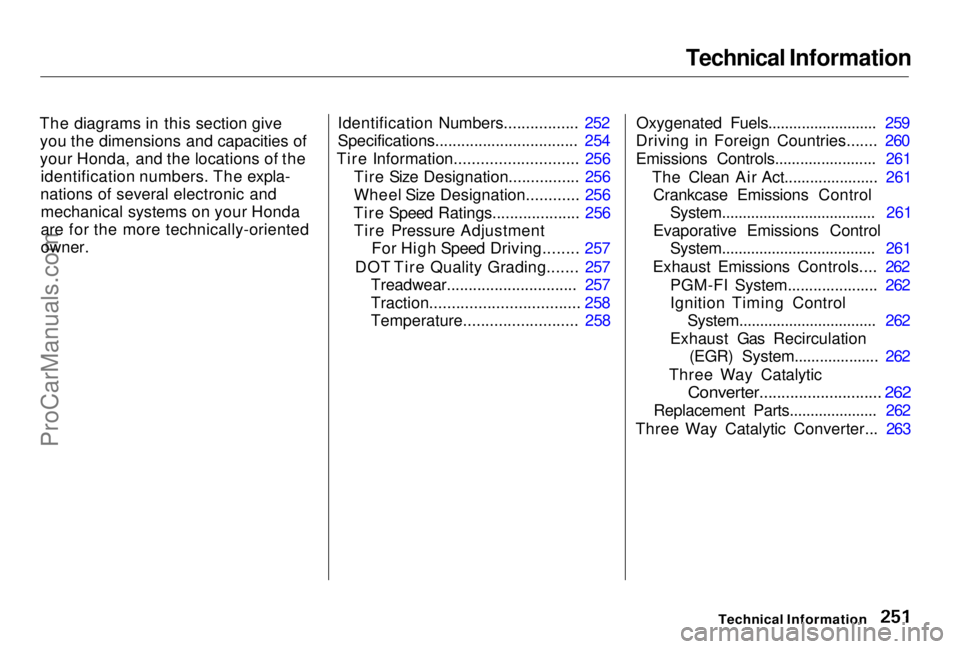
Technical Information
The diagrams in this section give you the dimensions and capacities of
your Honda, and the locations of the identification numbers. The expla-
nations of several electronic and mechanical systems on your Honda
are for the more technically-oriented
owner. Identification Numbers................. 252
Specifications................................. 254
Tire Information............................ 256 Tire Size Designation................ 256
Wheel Size Designation............ 256
Tire Speed Ratings.................... 256 Tire Pressure Adjustment For High Speed Driving........ 257
DOT Tire Quality Grading....... 257 Treadwear.............................. 257
Traction.................................. 258
Temperature.......................... 258 Oxygenated Fuels.......................... 259
Driving in Foreign Countries....... 260
Emissions Controls........................ 261
The Clean Air Act...................... 261Crankcase Emissions Control System..................................... 261
Evaporative Emissions Control System..................................... 261
Exhaust Emissions Controls.... 262 PGM-FI System..................... 262
Ignition Timing ControlSystem................................. 262
Exhaust Gas Recirculation (EGR) System.................... 262
Three Way Catalytic
Converter............................ 262
Replacement Parts..................... 262
Three Way Catalytic Converter... 263
Technical InformationProCarManuals.comMain Menu s t
Page 249 of 278
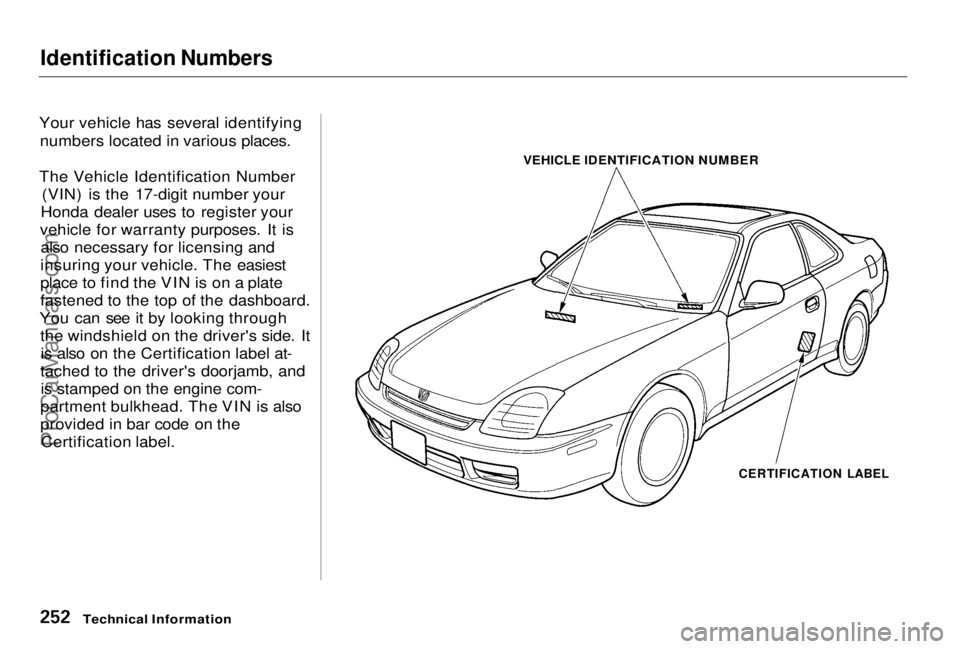
Identification Numbers
Your vehicle has several identifying numbers located in various places.
The Vehicle Identification Number (VIN) is the 17-digit number your
Honda dealer uses to register your
vehicle for warranty purposes. It is also necessary for licensing and
insuring your vehicle. The easiest
place to find the VIN is on a plate
fastened to the top of the dashboard.
You can see it by looking through the windshield on the driver's side. Itis also on the Certification label at-
tached to the driver's doorjamb, and is stamped on the engine com-
partment bulkhead. The VIN is also
provided in bar code on the Certification label.
Technical Information
VEHICLE IDENTIFICATION NUMBER
CERTIFICATION LABELProCarManuals.comMain Menu Table of Contents s t
Page 250 of 278
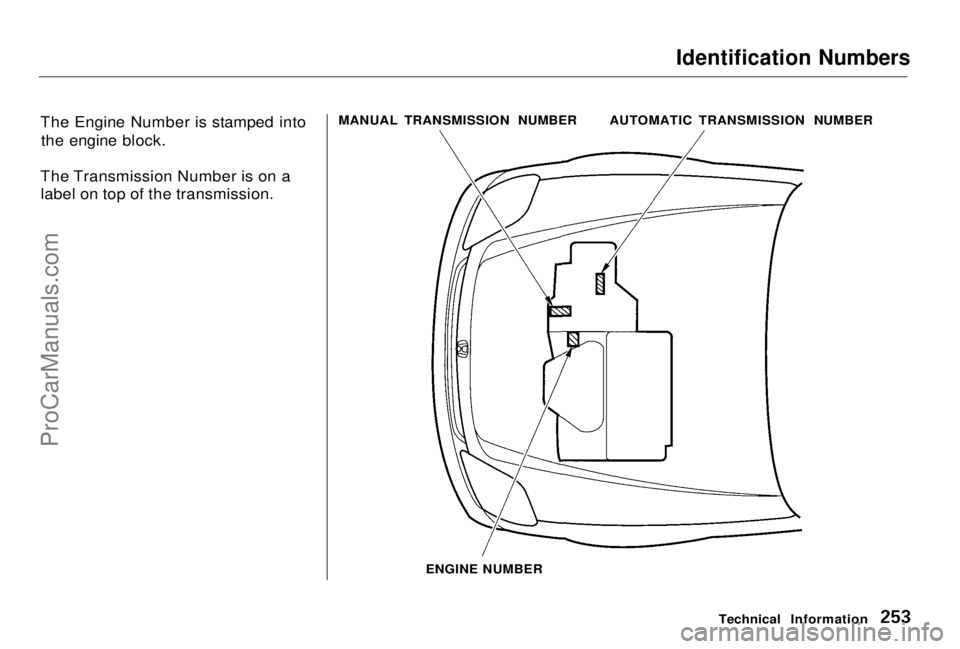
Identification Numbers
The Engine Number is stamped into the engine block.
The Transmission Number is on a label on top of the transmission. MANUAL TRANSMISSION NUMBER
ENGINE NUMBER Technical Information
AUTOMATIC TRANSMISSION NUMBERProCarManuals.comMain Menu Table of Contents s t